John
and I went into Prague first and again had breakfast at Yvette’s restaurant. Today
there were no queues for security at the castle although the area was busy when
we did go through. We were here mainly for 2 caches and some photos, which was
lucky as it was both cold in the wind (I had 2 jackets and John didn’t) and the
Cathedral was not open until midday. I did suggest he buy an extra layer but we
didn’t find anything suitable. We did get good photos of the Golden Gate at the
Cathedral.
Once
we walked down from the Castle it was warmer as we were out of the wind. We
headed for a cache near the Royal Route and stopped to take photos of the
street leading to the castle and then for a coffee. The street is full of what
were called burgher houses. The cache was around the corner at the alchemist museum.
It was a quiet and attractive spot with a café inside and was part of a hostel.
The cache had over 1000 favourite points so we waited while some people passed in
order to get it. Luckily we could wander into the café area while waiting.
We
went a different way towards the town centre and found ourselves outside the US
Embassy. We had already realised this as we saw the flag. John then noticed the
policeman or security person on the street with a mirror. Cars were stopping,
opening their engines and the underneath of the cars was checked using the
mirror.
We
had decided to do an afternoon tour and met the guide at the Powder Tower.
This
was a paid ‘WW2 Occupation’ tour and there were 10 of us on it. The guide was
Czech, and very knowledgeable.
He
began showing us photos and, as with Cesky Krumlov, the significance then
dawned. We were first looking at the building where the Czech Ministers
accepted the terms of the Munich Agreement (“Peace in our time” - Chamberlain).
The guide was very considered. He had come to a personal conclusion that the
Munch Agreement (which had reduced the size of the Republic) had been wisely
accepted as it had saved the city and country from devastation. Other people in
the Republic call it the Munich Betrayal so his view in not held by everyone. He
showed us on maps the areas lost then, which were mainly those with significant
German, Hungarian and Polish majorities, however, they also lost most of their
border defences as well.
Of
course, we know now that Hitler did not keep his word when he said that would
be it – and he then showed us the photos of the German troops entering Prague a
few months later. I had not realised that the Czech leader had been called to
meet with Hitler at midnight to be told either tell your army not to resist or
we bomb Prague. The Czech leader had a heart attack but Hitler’s physician gave
him treatment and he survived to accept the ‘offer’ and for the land to became
a Protectorate of the Reich.
The
Czech army was disarmed, but became the core of the local resistance, while
others left the area and fought with French and British troops as the free
Czech army.
We next saw an apartment that had been the base for a resistance
group. The resistance had been reasonably successful and had managed to
sabotage vehicles and disorient troops until the German authorities lost
patience. At that stage a lot of spying happened and tracking of radio signals
from unmarked cars. Students also lead protests which led to the universities
being closed and 1209 students sent to concentration camps.
The
resistance was operating under the leadership of the exiled President Benes. The
next part of the tour related to the assassination of the SS coomander Reinhard
Heydrick. The tour guide said that the local Resistance were initially opposed
to the action as they both feared reprisals and also they felt he was the devil
they knew. The Czech authorities in Britain insisted that it was required to
show that the Czechs deserved to have their nation back. Apparently Churchill
had told Benes that his country did not exist so he was, with respect, just an
individual.
We
heard first about life in the Protectorate. After the German authorities got
annoyed with the Czech people’s passive resistance, Heydrick was sent to sort
things out. He was a musician who would play when he had time with the Prague
orchestra but that was his only soft side it appears. The guides mother was a
child at the time and he told us a story from her youth.
Prior
to Heydrick arriving there, farmers had been able to kill animals to sell. He
instituted a rule that everything had to be sold to the German army.
His mother’s
family were farmers and had killed a pig. The army arrived and searched the
house for evidence. When they left without finding anything, they said if the
family killed another animal and kept its meat, the family would all be killed.
Our guide said that his uncle had processed the meat a number of metres from
the house to avoid any traces and managed to just avoid evidence being found.
They never took that risk again.
Heydrick
was also clever. His first action was to increase the food allowances and other
perks for the workers. Those who worked very hard for the Reich were rewarded
and this induced loyalty. It was cost free as the extra allowances were taken
from the Jews and Gypsies.
We
were taken underground and told that the original settlements were now buried
under the new buildings, but some were still accessible. The part we went to
was under the Town Hall and used really to help us imagine the next part of the
story. John knew most of it but I didn’t.
In
brief, 2 soldiers, one Czech and one Slovak were offered the job of
assassinating Heydrick.
One was injured when they parachuted in and they were
nearly caught then as the ‘friendly’ forester who helped them was an agent for
the Germans. They killed him and made contact, after some delays, with the
local resistance. They managed to blow up Heydrick’s car on about the last
possible day although a Sten Gun misfired and the bomb was not as destructive
as they hoped. Heydrick died in hospital as a result of his wounds and
infection. The 2 agents were betrayed by one of their support group who was
concerned about reprisals to his family and their village. This followed the total destruction of a
village because of false information that the people there had supported the
assassins. The assassins were hiding in a crypt under a church with helpers and
all killed themselves before they could be captured having been surrounded by
700 troops.
Mention was made of the plight of the Jews at this time although it was not the main focus of the tour. On our way to the last spot, our guide pointed out a memorial plaque on the footpath.
When a person is identified as having lived in a specific place, a small plaque record their details. There are many of these in the area, all equally inconspicuous but still significant.
We
did not have time to go to the actual underground crypt. Although it was not
far away from where the tour ended, it was due to close at 5pm and would not be
open the next day. It was a little disappointing but the tour overall had been
very worthwhile.
We
walked back alongside the river and stopped for a drink in a pub (rich hot
chocolates) before we climbed the tower at Charles Bridge for both photos in
all directions and a rather cheeky cache which is on the top level as well.
We
had dinner at the place we had discovered on the first day near our base. Then
we found a cache at a nearby Stadium and John learned a bit about a famous
Czech footballer (Josef Masopust) whose statue was on display. Katherine and Jess arrived back ‘home’
not long after us, and plans were finalised for tomorrow. It was then time for
bed.

 Prague, Prague, Czech Republic
Prague, Prague, Czech Republic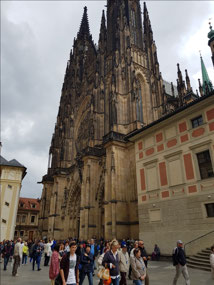
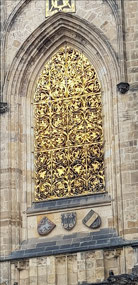
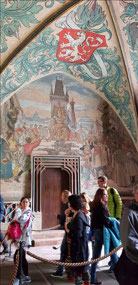
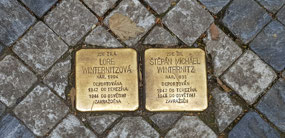
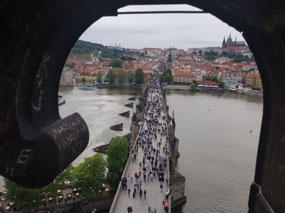
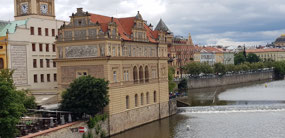







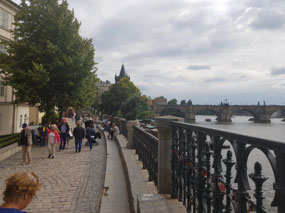
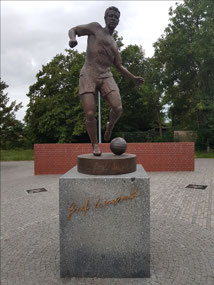
2025-05-22